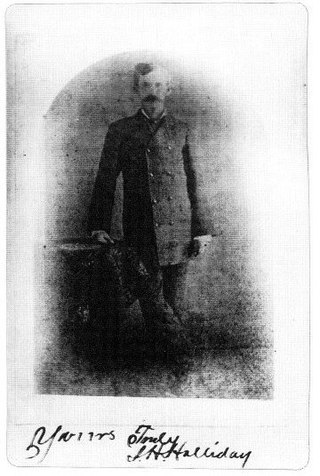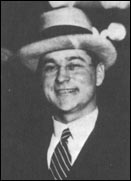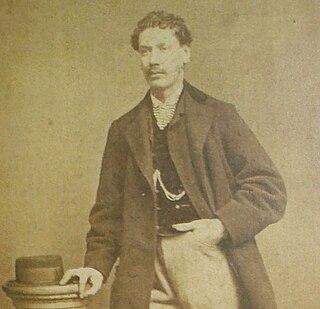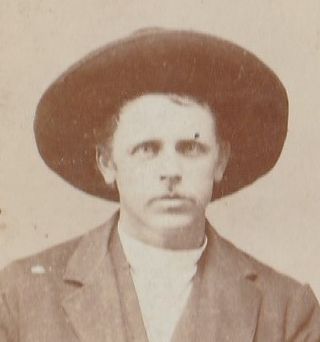
John HenryHolliday, better known as Doc Holliday, was an American dentist, gambler, and gunfighter who was a close friend and associate of lawman Wyatt Earp. Holliday is best known for his role in the events surrounding and his participation in the Gunfight at the O.K. Corral in Tombstone, Arizona. He developed a reputation as having killed more than a dozen men in various altercations, but modern researchers have concluded that, contrary to popular myth-making, Holliday killed only one to three men. Holliday's colorful life and character have been depicted in many books and portrayed by well-known actors in numerous movies and television series.

Wyatt Berry Stapp Earp was an American lawman and gambler in the American West, including Dodge City, Deadwood, and Tombstone. Earp was involved in the famous gunfight at the O.K. Corral, during which lawmen killed three outlaw Cochise County Cowboys. While Wyatt is often depicted as the key figure in the shootout, his brother Virgil was both Deputy U.S. Marshal and Tombstone City Marshal that day and had considerably more experience in law enforcement as a sheriff, constable, and marshal than did Wyatt. Virgil made the decision to enforce a city ordinance prohibiting carrying weapons in town and to disarm the Cowboys. Wyatt was only a temporary assistant marshal to his brother.

Lou Blonger, born Louis Herbert Belonger, was a Wild West saloonkeeper, gambling-house owner, and mine speculator, but is best known as the kingpin of an extensive ring of confidence tricksters that operated for more than 25 years in Denver, Colorado. His "Million-Dollar Bunco Ring" was brought to justice in a famous trial in 1923.

Bartholemew William Barclay "Bat" Masterson was a U.S. Army scout, lawman, professional gambler, and journalist known for his exploits in the late 19th and early 20th-century American Old West. He was born to a working-class Irish family in Quebec, but he moved to the Western frontier as a young man and quickly distinguished himself as a buffalo hunter, civilian scout, and Indian fighter on the Great Plains. He later earned fame as a gunfighter and sheriff in Dodge City, Kansas, during which time he was involved in several notable shootouts.

Robert A. Clay Allison also known as Clay Allison was a cattle rancher, cattle broker, and sometimes gunfighter of the American Old West. He fought for the Confederacy in the Civil War. Allison had a reputation for violence, having survived several one-on-one knife and gunfights, as well as being implicated in a number of vigilante jail break-ins and lynchings. A drunken Allison once rode his horse through town nearly naked—wearing only his gunbelt. Later most reports stated that he was not only dangerous to others but himself, accidentally shooting himself in the foot.

John Peters Ringo was an American Old West outlaw loosely associated with the Cochise County Cowboys in frontier boomtown Tombstone, Arizona Territory. He took part in the Mason County War in Texas during which he committed his first murder. He was arrested and charged with murder. He was affiliated with Cochise County Sheriff Johnny Behan, Ike Clanton, and Frank Stilwell during 1881–1882. He got into a confrontation in Tombstone with Doc Holliday and was suspected by Wyatt Earp of having taken part in the attempted murder of Virgil Earp and the ambush and death of Morgan Earp. Ringo was found dead with a bullet wound to his temple which was ruled a suicide. Modern writers have advanced various theories attributing his death to Wyatt Earp, Doc Holliday, Frank Leslie or Michael O'Rourke.

Louis "Two Gun" Alterie, born Leland A. Varain, and aka "Diamond Jack Alterie", was a Californian who became a notorious hitman for the Chicago North Side Gang during the early years of Prohibition.

William Brocius, better known as Curly Bill Brocius, was an American gunman, rustler and an outlaw Cowboy in the Cochise County area of the Arizona Territory during the late 1870s and early 1880s. His name is likely an alias or nickname, and some evidence links him to another outlaw named William "Curly Bill" Bresnaham, who was convicted of an 1878 attempted robbery and murder in El Paso, Texas.

Joseph Isaac Clanton was a member of a loose association of outlaws known as The Cowboys who clashed with lawmen Wyatt, Virgil and Morgan Earp as well as Doc Holliday. On October 26, 1881, Clanton was present at the Gunfight at the O.K. Corral in the boomtown of Tombstone, Arizona Territory but was unarmed and ran from the gunfight, in which his 19-year-old brother Billy was killed.

Luke Lamar Short was an American Old West gunfighter, cowboy, U.S. Army scout, dispatch rider, gambler, boxing promoter, and saloon owner. He survived numerous gunfights, the most famous of which were against Charlie Storms in Tombstone, Arizona Territory, and against Jim Courtright in Fort Worth, Texas. Short had business interests in three of the best-known saloons in the Old West: the Oriental in Tombstone, the Long Branch Saloon in Dodge City, and the White Elephant in Fort Worth.

David Rudabaugh was a cowboy, outlaw and gunfighter in the American Old West. Modern writers often refer to him as "Dirty Dave" because of his alleged aversion to water, though no evidence has emerged to show that he was ever referred to as such in his own lifetime.
Mary Katherine Horony Cummings, popularly known as Big Nose Kate, was a Hungarian-born American outlaw, gambler, prostitute and longtime companion and common-law wife of Old West gambler and gunfighter Doc Holliday. "Tough, stubborn and fearless", she was educated, but chose to work as a prostitute due to the independence it provided her. She is the only woman with whom Holliday is known to have had a relationship.

The Earp Vendetta Ride was a deadly search by a federal posse led by Deputy U.S. Marshal Wyatt Earp for a loose confederation of outlaw "Cowboys" they believed had ambushed his brothers Virgil and Morgan Earp, maiming the former and killing the latter. The two Earp brothers had been attacked in retaliation for the deaths of three Cowboys in the Gunfight at the O.K. Corral on October 26, 1881. From March 20 to April 15, 1882, the federal posse searched southeast Cochise County, Arizona Territory for the men they believed were responsible for the attacks on Virgil and Morgan. Several suspects had been identified and were charged, but were soon released by the court, owing in some cases to legal technicalities and in others to the strength of alibis provided by the Cowboy gang. Wyatt subsequently pursued the suspects with a federal warrant.

Jefferson Randolph "Soapy" Smith II was an American con artist and gangster in the American frontier, and ultimately the Klondike.
Sherman McMaster (1853–1892) was an outlaw turned lawman, who was one of the six men involved in the Earp vendetta ride.

A Western saloon is a kind of bar particular to the Old West. Saloons served customers such as fur trappers, cowboys, soldiers, lumberjacks, businessmen, lawmen, outlaws, miners, and gamblers. A saloon might also be known as a "watering trough, bughouse, shebang, cantina, grogshop, and gin mill". The first saloon was established at Brown's Hole, Wyoming, in 1822, to serve fur trappers.

Frank C. Stilwell was an outlaw Cowboy who killed at least two men in Cochise County during 1877–82. Both killings were considered to have been self-defense. For four months he was a deputy sheriff in Tombstone, Arizona Territory for Cochise County Sheriff Johnny Behan. Stilwell owned interests in several mines and various businesses, including a saloon, a wholesale liquor business, a stage line, and at his death livery stables in Charleston and Bisbee. He was also a partner in a Bisbee-area saloon with ex-Texas Ranger Pete Spence.

Tom McLaury was an American outlaw. He and his brother Frank owned a ranch outside Tombstone, Arizona, Arizona Territory during the 1880s. He was a member of a group of outlaws Cowboys and cattle rustlers that had ongoing conflicts with lawmen Wyatt, Virgil, and Morgan Earp. The McLaury brothers repeatedly threatened the Earps because they interfered with the Cowboys' illegal activities. On October 26, 1881, Tom and Frank were both killed in the Gunfight at the O.K. Corral in Tombstone, Arizona Territory. The Tombstone shootout was his only gunfight.
Charles "Pony Diehl" Ray was an Old West outlaw in the New Mexico Territory and Arizona Territory. He was accused by Wyatt Earp of having taken part in an attempt to kill his brother, Virgil Earp. Diehl was not tried due to a lack of evidence.
Dan Tucker, better known as "Dangerous Dan" Tucker,, is a little-known Canadian-American lawman and gunfighter of the Old West.